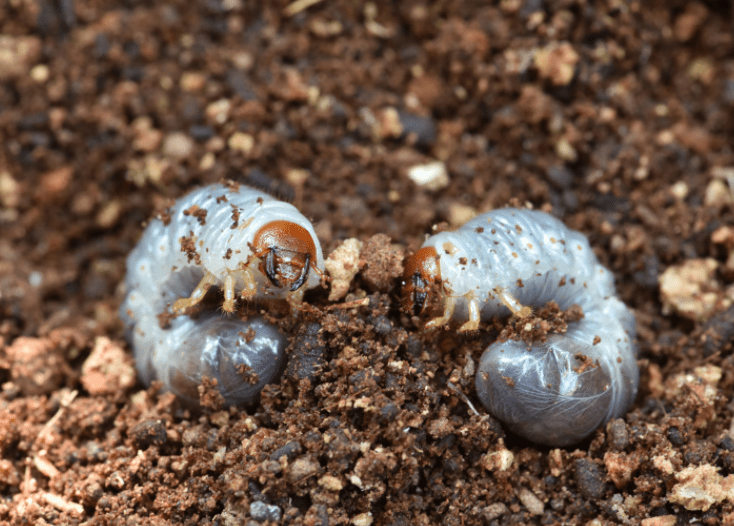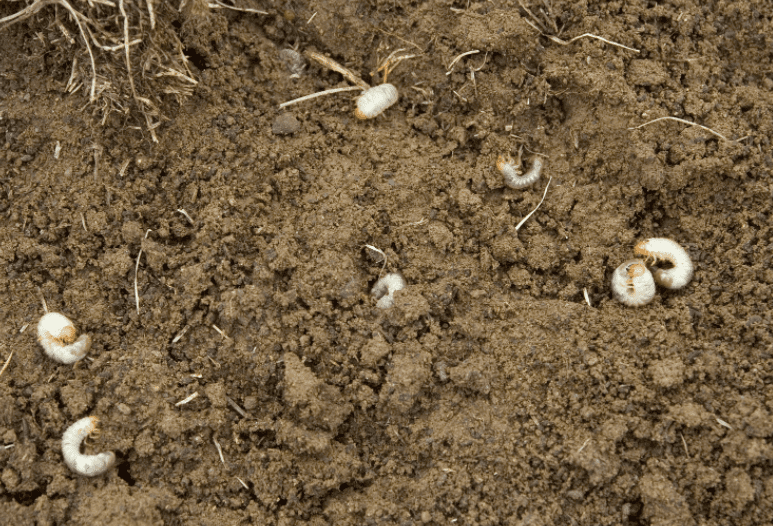
White Grubs Control
White grubs are the larval stages of beetles and are easily identifiable due to their characteristic white C-shaped body.
The annual white grub, whose adult is the tan chafer beetle, is much more common in northern Illinois. White grubs feed on lawn roots and cause damaged lawns to appear brown.
Damaged lawns usually are treated when the white grub population reaches 8 to 12 grubs per square foot. We can find these grubs by lifting the sod in the affected areas and checking the root zone for them.
In treating white grubs, timing and understanding the pest’s life cycle is critical for success. Adult beetles lay eggs in July, and most larvae are then present by early August. The annual white grub causes damage on lawns from mid-August to early October.
Therefore, it is essential to apply insecticides when the grubs are actively feeding before they become too large and when all populations are present.
White grubs can be treated using several insecticides. The most common include imidacloprid or Merit (formerly GrubEx) and halofenozide or Mach-2 (GrubBGon, GrubEx). Better results have been found by applying either imidacloprid (Merit) or halofenoziden (Mach- 2) in July before eggs are laid, and insect damage appears.
Mach-2 has also been found to be very effective on Japanese beetle insects when applied between June 21 to July 21.
It’s important to water in the insecticides once applied.

The Life History Of Grub Insects
The life history for most of these insects is similar, with slight variations in timing. Adults emerge in late spring and also early summer. Egg-laying begins soon, and the larvae hatch in June and July. Grubs reach maturity in late summer, with damage peaking in early fall.
As cold weather approaches, the larvae dig deeper in the soil to overwinter, then come up again in spring with the warmer temperatures.
Damage: Root feeding from white grubs damages turf, which often wilts and dies. The sod itself can become loose and occasionally be rolled up like a carpet.
Green June beetle larvae are different and damage grasses in another way. They feed primarily on decaying vegetation rather than grassroots. Their feeding causes extensive tunneling, which produces a spongy layer in the soil up to 2 inches deep.
This tunneling disturbs the contact between the soil and the plant roots and interferes with water uptake, causing the grass to die.
Green June beetle larvae are the only ones that come out onto the soil’s surface at night and move across the ground on their backs. Because of this behavior, this species comes in contact with pesticides more readily and is one of the easiest white grubs to control.
Symptoms Of Grubs Infestation
Though all grasses are potential targets, bluegrass and bentgrass are especially vulnerable.
Sometimes, symptoms are masked during periods of rapid growth and adequate water, so examine your sod. Sometimes the sight of birds feeding on lawns can show grubs are present. To be sure, a survey is necessary.
Water the soil thoroughly the day before if conditions are dry. Use a heavy spade or knife to cut several one-square-foot flaps of sod. For each, cut three sides and roll the turf back like a rug, and examine the top two to four inches of soil.
The insects will be C- shaped, cream-colored larvae with brown heads and a darker area at the posterior end. The presence of five to eight grubs per square foot requires treatment.
Control Of Grubs Infestation
Control: It is best achieved in late summer when most larvae have hatched but are still relatively small. When applying an insecticide for white grubs, we should water the soil before application if the ground is dry.
This will force the larvae to come closer to the surface. For specific soil pesticide recommendations, get in contact with your local county extension agent.
Other insecticides that have been used to control white grubs include Diazinon, isazophos (Triumph) and trichlorfon (Dylox, Proxol), and bendiocarb (Intercept). Organic control of the white grubs using nematodes (Heterorhabditis bacteriophora nematodes) has also been used.
They often sold these as Hb nematodes from mail-order catalogs. Reading and following label directions for all insecticides is critical.


























Comments are closed.